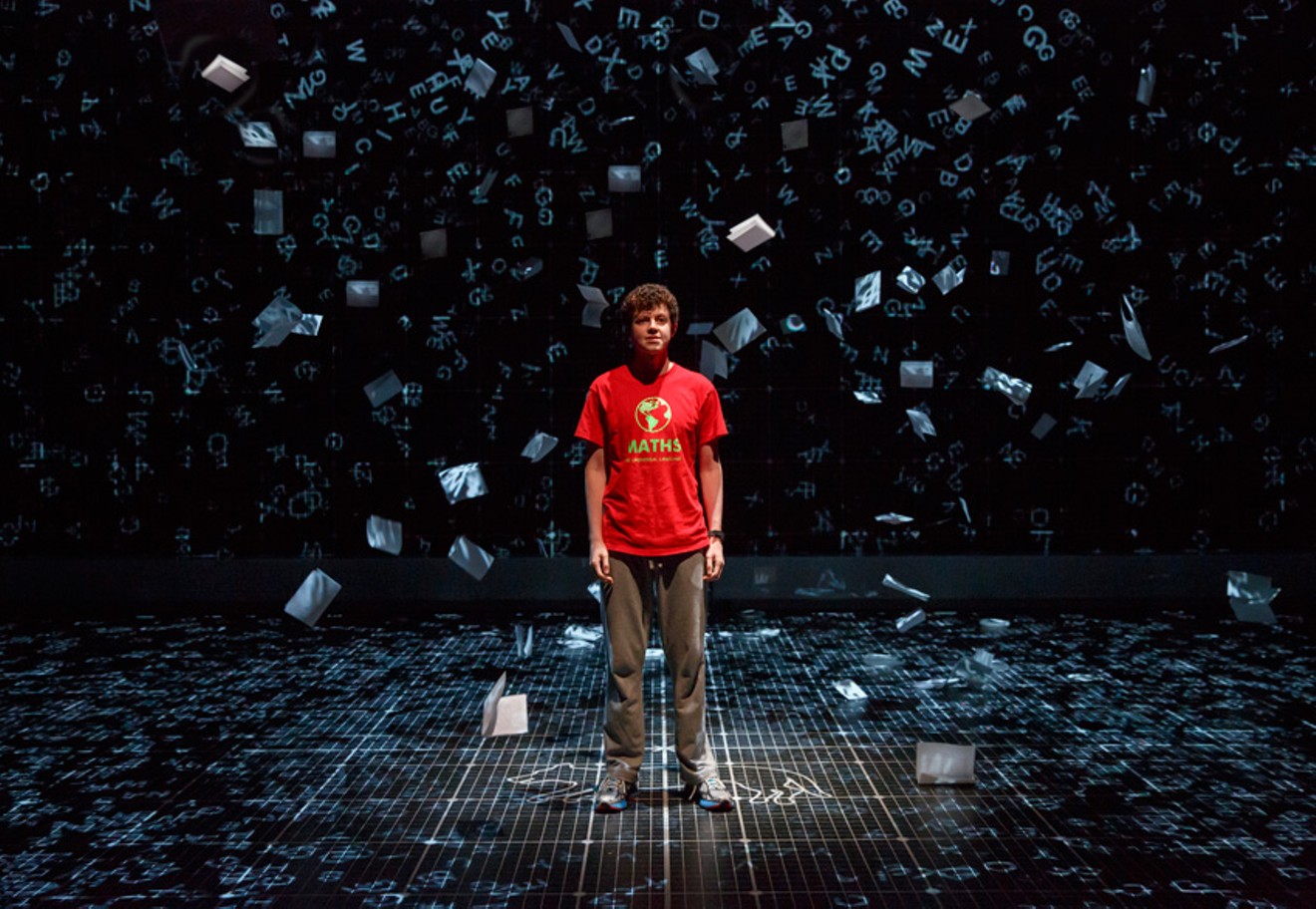A huge critical hit in both London and New York, The Curious Incident of the Dog in the Night-Time is based on a novel by Mark Haddon that is written from the viewpoint of a fifteen-year-old boy, Christopher, who’s somewhere on the autism-Asperger spectrum. Christopher discovers the corpse of his neighbors’ dog, Wellington, who’s been killed with a garden fork. He’s naturally distressed, but he’s also a fan of Sherlock Holmes, and he decides to unravel the mystery of Wellington’s death. The exercise leads him into unexpected and deeply unsettling familial depths. These events would be hard for anyone to cope with, but this teenager is trapped in his own literal mind (he hates metaphor) and has constructed a narrowly logical and predictable world in which he feels safe. Now that world is being battered from every side — and Christopher with it.
Playwright Simon Stephens introduced a twist to the plot that doesn't make much sense: A sympathetic teacher persuades Christopher to turn an account of his sleuthing into a play — the play we’re seeing. What concerned teacher would persuade a vulnerable kid to air his family’s betrayal-filled story on a stage, risking all kinds of trouble, including a potential lawsuit? For that matter, it’s hard to figure out how you’d kill a poodle with a garden fork, though I’m sure it can be done — or why an audience is supposed to find the sight of an adorable puppy in the hands of the man who did the deed cute or redemptive. (I have to admit, though, that the live yellow pup that scampers across the stage at the Ellie is heart-meltingly cute.)
Adam Langdon, who played Christopher in the touring production on the night I attended, gives what seems to me an accurate rendition of an autistic teenager. When Christopher’s not in acute distress, he sometimes moves into lecture mode, or appears unaffected by others to the point of being annoying; it's a skilled performance, though one that generates more interest than empathy. The rest of the cast is strong, too; it includes Colorado’s Gene Gillette’s complex work as Christopher’s father, a man capable of violence and dishonesty, yet who musters all the love and empathy he’s capable of for the sake of his son. Christopher’s mother, Judy, as played by Felicity Jones Latta, is thoughtless, but also vital and capable of protective tenderness, and Maria Elena Ramirez brings warmth to the role of teacher Siobhan.
But the primary focus of director Marianne Elliott (who won one of this production’s five Tony Awards) is on communicating Christopher’s inner world, a difficult task at which she, along with the choreographers and set, lighting and sound designers, succeeds magnificently. We know that Christopher, a brilliant young mathematician, hates to be touched, doesn’t understand ordinary social intercourse, curls up and howls at unexpected events. We know he deals in small, controllable bits of data, along with large, clean, mind-freeing concepts involving space and the stars. But what we long to know — as do those who love him — is what it feels like to be Christopher.
Over the past few years, I’ve been seeing more and more shows that rely on tech, or a mixture of moving human bodies and technical elements, to communicate ideas, action and emotion; this is the most striking. The set is austere, with three sides consisting of what looks like graph paper — orderly squares marching from side to side and floor to ceiling. But then numbers, lines and images on the graphs curve, change and spill. Huge ear-shredding sounds convey Christopher’s moments of meltdown. Particularly exciting is the way light, movement and color — or lack of color — convey the effect of a London underground station on the teenager’s overwhelmed mind. Then there’s the moment when Christopher’s pet rat (a real rat) escapes onto the train tracks and Christopher jumps down to reclaim him. As the train bears down while two commuters argue about what should be done, we find ourselves silently praying that somebody will take action.
This may be as close as you’ll ever get to understanding the sealed-off world of autism — and how it holds power and illumination as well as loneliness and grief.
Curious Incident of the Dog in the Night-Time, presented by the Denver Center for the Performing Arts through June 18, Ellie Caulkins Opera House, Denver Performing Arts Complex, 303-893-4100, denvercenter.org.
[
{
"name": "Air - MediumRectangle - Inline Content - Mobile Display Size",
"component": "12017618",
"insertPoint": "2",
"requiredCountToDisplay": "2"
},{
"name": "Editor Picks",
"component": "17242653",
"insertPoint": "4",
"requiredCountToDisplay": "1"
},{
"name": "Inline Links",
"component": "18838239",
"insertPoint": "8th",
"startingPoint": 8,
"requiredCountToDisplay": "7",
"maxInsertions": 25
},{
"name": "Air - MediumRectangle - Combo - Inline Content",
"component": "17261320",
"insertPoint": "8th",
"startingPoint": 8,
"requiredCountToDisplay": "7",
"maxInsertions": 25
},{
"name": "Inline Links",
"component": "18838239",
"insertPoint": "8th",
"startingPoint": 12,
"requiredCountToDisplay": "11",
"maxInsertions": 25
},{
"name": "Air - Leaderboard Tower - Combo - Inline Content",
"component": "17261321",
"insertPoint": "8th",
"startingPoint": 12,
"requiredCountToDisplay": "11",
"maxInsertions": 25
}
]












